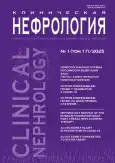Gender differences in kidney function in COVID-19
- Authors: Perepelitsa S.A.1
-
Affiliations:
- Imannuel Kant Baltic Federal University
- Issue: Vol 17, No 1 (2025)
- Pages: 18-21
- Section: Original Articles
- URL: https://journal-vniispk.ru/2075-3594/article/view/293195
- DOI: https://doi.org/10.18565/nephrology.2025.1.18-21
- ID: 293195
Cite item
Abstract
Objective. Identification of gender differences in the kidney function in patients with COVID-19.
Material and methods. The study included 504 patients who were treated for the diagnosis of «Novel coronavirus infection caused by the SARS-CoV-2 virus». Patients were divided into two groups by gender: group A – 311 women, the mean age was 63.1±15.3 years, body mass index (BMI) – 28.8±6.1 kg/m2; group B – 193 men, the mean age was 58.3±15.9 years, BMI – 27.8±5.8 kg/m2. Blood serum creatinine levels were determined, the glomerular filtration rate (GFR) was calculated.
Results. On admission, 68.8% of women and 53.8% of men had signs of renal dysfunction, since the GFR was reduced; by the 7th day, renal function had not returned to normal in 33.6% of women and 43.1% of men, since the GFR remained reduced.
Conclusion. The course of COVID-19 has gender differences, which must be taken into account in clinical practice.
Full Text
##article.viewOnOriginalSite##About the authors
Svetlana A. Perepelitsa
Imannuel Kant Baltic Federal University
Author for correspondence.
Email: sveta_perepeliza@mail.ru
ORCID iD: 0000-0002-4535-9805
Dr. Sci. (Med.), Head of the Department of Surgical Disciplines of the Educational Scientific Cluster «Institute of Medicine and Life Sciences»
Russian Federation, 14 A.Nevsky str., Kaliningrad, 236041References
- Hoste E.A.J., Kellum J.A., Selby N.M., et al. Global epidemiology and outcomes of acute kidney injury. Nat. Rev. Nephrol. 2018;14(10):607–25. doi: 10.1038/s41581-018-0052-0.
- Pickkers P., Darmon M., Hoste E., et al. Acute kidney injury in the critically ill: an updated review on pathophysiology and management. Intens. Care Med. 2021;47(8):835–50. doi: 10.1007/s00134-021-06454-7.
- James M.T, Bhatt M., Pannu N., et al. Long-term outcomes of acute kidney injury and strategies for improved care. Nat. Rev. Nephrol. 2020;16(4):193–205. doi: 10.1038/s41581-019-0247-z.
- Kellum J.A., Prowle J.R. Paradigms of acute kidney injury in the intensive care setting. Nat. Rev. Nephrol. 2018;14(4):217–30. doi: 10.1038/nrneph.2017.184.
- Chancharoenthana W., Leelahavanichkul A., Schultz M.J., et al. Going Micro in Leptospirosis Kidney Dis. Cells. 2022;11(4):698. doi: 10.3390/cells11040698.
- Rahman M., Schellhorn H.E. Metabolomics of infectious diseases in the era of personalized medicine. Front. Mol. Biosci. 2023;10:1120376. doi: 10.3389/fmolb.2023.1120376.
- Jansen J., Reimer K.C., Nagai J.S., et. al. SARS-CoV-2 infects the human kidney and drives fibrosis in kidney organoids. Cell Stem Cell. 2022;29(2):217–31.e8. doi: 10.1016/j.stem.2021.12.010.
- Khan S., Chen L., Yang C.-R., et al. Does SARS-CoV-2 Infect the Kidney? J. Am. Soc. Nephrol. 2020;31(12):2746–8. doi: 10.1681/ASN.2020081229.
- Puelles V.G., Lütgehetmann M., Lindenmeyer M.T., et al. Multiorgan and Renal Tropism of SARS-CoV-2. N. Engl. J. Med. 2020;383(6):590–2. doi: 10.1056/NEJMc2011400.
- Stewart B.J., Ferdinand J.R., Young M.D., et al. Spatiotemporal immune zonation of the human kidney. Science. 2019;365(6460):1461–6. doi: 10.1126/science.aat5031.
- Limbutara K., Chou .C.L., Knepper M.A. Quantitative proteomics of all 14 renal tubule segments in rat. J. Am. Soc. Nephrol 2020;31(6):1255–66. doi: 10.1681/ASN.2020010071.
- Boraschi P., Giugliano L., Mercogliano G., et al. Abdominal and gastrointestinal manifestations in COVID-19 patients: Is imaging useful? World J. Gastroenterol. 2021;27(26):4143–59. doi: 10.3748/wjg.v27.i26.4143.
- Клинические рекомендации Острое повреждение почек (ОПП). 2020 г. https://rusnephrology.org/professional/gudlines. Дата обращения 02.01.2025 г. Clinical guidelines Acute kidney injury (AKI). 2020. https://rusnephrology.org/professional/gudlines. Date of access 02.01.2025.
- Клинические рекомендации Хроническая болезнь почек. 2024 г. https://cr.minzdrav.gov.ru/preview-cr/469_3. Дата обращения 02.01.2025г. Clinical guidelines Chronic kidney disease. 2024. https://cr.minzdrav.gov.ru/preview-cr/469_3. Accessed 02.01.2025.
- Wyss M., Kaddurah-Daouk R. Creatine and creatinine metabolism. Physiol. Rev. 2000;80(3):1107–213. doi: 10.1152/physrev.2000.80.3.1107.
- Prowle J.R., Leitch .A, Kirwan C.J., et al. Positive fluid balance and AKI diagnosis: assessing the extent and duration of ‘creatinine dilution’. Intens. Care Med. 2015;41(1):160–1. doi: 10.1007/s00134-014-3538-7.
- Haines R.W., Fowler A.J., Liang K., et al. Comparison of Cystatin C and Creatinine in the Assessment of Measured Kidney Function during Critical Illness. Clin. J. Am. Soc. Nephrol. 2023;18 (8):997–1005. doi: 10.2215/CJN.0000000000000203.
- Chawla L.S., Bellomo R., Bihorac A., et al. Acute kidney disease and renal recovery: consensus report of the Acute Disease Quality Initiative (ADQI) 16 Workgroup. Nat. Rev. Nephrol. 2017;13(4):241–57. doi: 10.1038/nrneph.2017.2.
- Prowle J.R., Kolic I., Purdell-Lewis J., et al. Serum creatinine changes associated with critical illness and detection of persistent renal dysfunction after AKI. Clin. J. Am. Soc. Nephrol. 2014;9(6):1015–23. doi: 10.2215/CJN.11141113.
- Bunders M.J., Altfeld M. Implications of sex differences in immunity for SARS-CoV-2 pathogenesis and design of therapeutic interventions. Immunity. 2020;53(3):487–95. doi: 10.1016/j.immuni.2020.08.003.
- Pairo-Castineira E., Clohisey S., Klaric L., et al. GenOMICC Investigators. ISARICC Investigators. COVID-19 Human Genetics Initiative. 23andMe Investigators. BRACOVID Investigators. Gen-COVID Investigators Genetic mechanisms of critical illness in Covid-19. Nature. 2020. doi: 10.1038/s41586-020-03065-y.
Supplementary files












